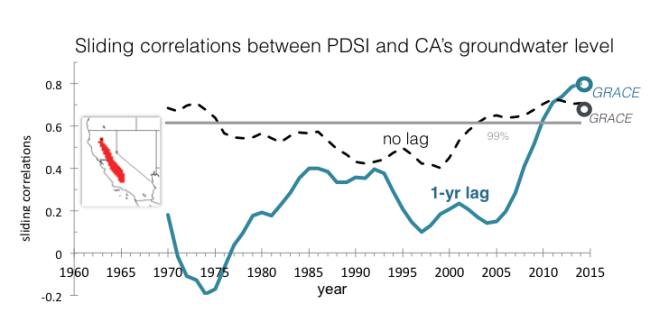Protracted groundwater depletion in California after drought – could 2016-17 be worse?
This past winter, most water agencies across California were counting on the strong El Niño to produce surplus water to recharge the groundwater and make up for what’s been pumped out due to the severe drought. However, the precipitation barely equaled the average in the state, despite El Niño-driven storms during this winter. A new study found that the groundwater level in California’s Central Valley has continued to decline even when drought has recovered.

Increase in the lagged correlation suggests protracted groundwater depletion one year after the drought. Sliding correlations between the Central Valley Palmer drought severity index (PDSI) and the groundwater level (GW) in the following year (1-yr lag; solid line) and in the same year (no lag; dashed line), computed with a 15-year running window (one-sided). Thick circles indicate the correlations of the GRACE liquid water equivalent with PDSI for 2002-2014. The gray horizontal line indicates the 99% confidence interval.
Within the Central Valley, drought and increased groundwater depletion occurs almost hand in hand, and when drought ends, groundwater storage rebounds. But this relationship has changed over the last decade. Analyzing about 500 wells and the Gravity Recovery and Climate Experiment (GRACE) estimated storage, the authors showed a continued depletion of groundwater lasting a full year after drought; this phenomenon was not observed in earlier records before the 21st century. Possible causes include 1) lengthening of drought associated with amplification in the 4 to 6-year El Niño frequency since the late 1990s, and 2) intensification of drought and increased pumping that enhances depletion. The implication is that current groundwater storage in the Central Valley will likely continue to diminish further in 2016, even if the recent El Niño did mitigate the drought.
The effects of drought in California are becoming overarching and can be enduring. Despite changing water use habits, the water table continues to drop while drought becomes longer and more severe. The groundwater table in the Central Valley has been declining to such a degree that it requires a deeper understanding of the temporal dynamics of drought as well as their dependence on regional climate variability and change.
Indications for Protracted Groundwater Depletion after Drought over the Central Valley of California (Journal of Hydrometeorology)
1Utah State University
2U.S. Geological Survey
Topics
- Climate Change
- ENSO
- Extreme Events
